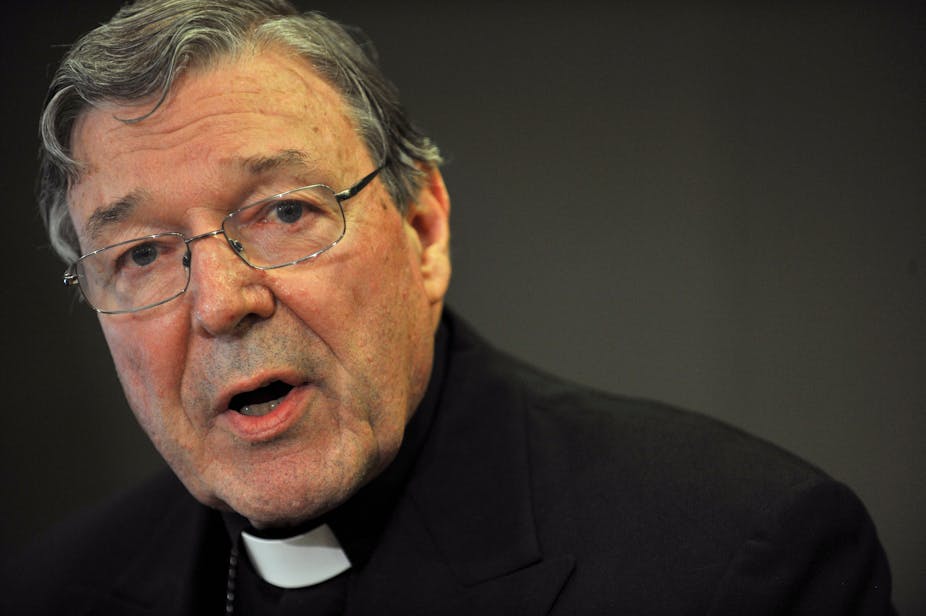Cardinal George Pell’s appearance at the Royal Commission into Institutional Responses to Child Sexual Abuse will do little to rehabilitate his image in the eyes of clergy abuse victims.
Via video link from the Vatican, Pell used the example of a trucking company to illustrate the legal responsibility of the Catholic Church to victims of clergy abuse. In his view, the church’s responsibility to those abused by priests is comparable to the responsibility of a trucking company to a hitchhiker raped by a trucker.
This was just one of several moments before the royal commission in which Pell’s rhetoric of concern for victims came into tension with the detached and bureaucratic manner that has characterised his response to clergy abuse over the last two decades.
The Melbourne Response
At the royal commission, Pell strongly defended the Melbourne Response, the clergy abuse compensation scheme that he established in 1996 as Archbishop of Melbourne. He described the scheme as an attempt to lessen the suffering of victims and to address their needs quickly and compassionately.
However, Pell’s statement that “money was never my primary concern” sat uncomfortably alongside his emphasis on protecting the financial resources of the archdiocese. Compensation offers were considerably lower than the likely outcome of a successful civil claim.
Under the Melbourne Response, offers of compensation were contingent on the signing of a deed of release. Many victims believed that, in signing the deed, they were obliged not to speak to the media or pursue a common law claim against the church.
Until 2002, the church’s lawyers warned victims that any allegation against the church would be “strenuously defended” if they opted for civil action instead of compensation.
The scheme has been the subject of vocal criticism from victims and survivor groups, who have argued that the Melbourne Response was established primarily to minimise the risk and cost of legal action against the church.
Questions of independence
The Melbourne Response has four distinct arms. It is involved in the investigation of allegations, counselling and support to victims, the assessment and provision of ex gratia payments to victims, and pastoral care.
These four arms operate ostensibly independently from one another. It has been argued that all four aspects of the Melbourne Response are under the control of the church, but this is hotly contested. Victim groups have also complained of a lack of external scrutiny or oversight.
The independence of these four arms has been questioned at the royal commission. It has emerged that the church’s law firm, Corrs Chambers Westgarth, has been responsible for managing legal matters for all aspects of the Melbourne Response. Earlier this week, Corrs Chambers Westgarth partner Richard Leder denied that any breach of confidentiality had occurred despite the law firm working across the Melbourne Response.
Other potential points of conflict have arisen over time. Under the scheme, Professor Richard Ball, the psychiatrist overseeing the treatment and assessment of perpetrating priests, also came to oversee the treatment of clergy abuse victims. This was despite the objections of victim groups at the time.
Earlier in the week, the Catholic Church’s independent commissioner, Peter O'Callaghan QC, could not explain how he received confidential information about a paedophile priest. He was also unable to explain why this information was passed to the church’s lawyers.
Charity or responsibility
At the royal commission, Pell framed the Melbourne Response as an act of charity by a generous church reaching out to those in need. He insisted on the moral responsibility of the church to alleviate suffering, but not the responsibility of the church for clergy abuse itself.
To the contrary, responsibility for clergy abuse was assigned elsewhere. Concerningly, the metaphor of the rapist trucker and the hitchhiker could suggest something of a shared responsibility between perpetrator and victim.
Throughout his appearance, Pell focused on the “choices” that victims make: the choice of the Melbourne Response or a “strenuously defended” lawsuit; the choice of accessing church counselling for free or paying for it elsewhere. Of course, given the diminished circumstances and vulnerability of many survivors, and the extraordinary wealth and power of the church, such choices are not freely made. However, this was not a point of concern for Pell.
From Pell’s perspective, the church was kind enough to offer support to a group of needy people, and it was up to them to take that support or not. Any hardship that resulted from their choices was their burden to accept, even though it was the church that determined the choices available to them.
Like the head of a trucking company dispensing charity to the raped hitchhiker, Pell did not accept that clergy abuse survivors have a specific moral or legal claim on the church.
It is hard to avoid the impression that, like hitchhikers thumbing a ride on a highway, clergy abuse victims are still being held responsible for the harms they have experienced, and they are expected to feel grateful for any display of support from the church.

